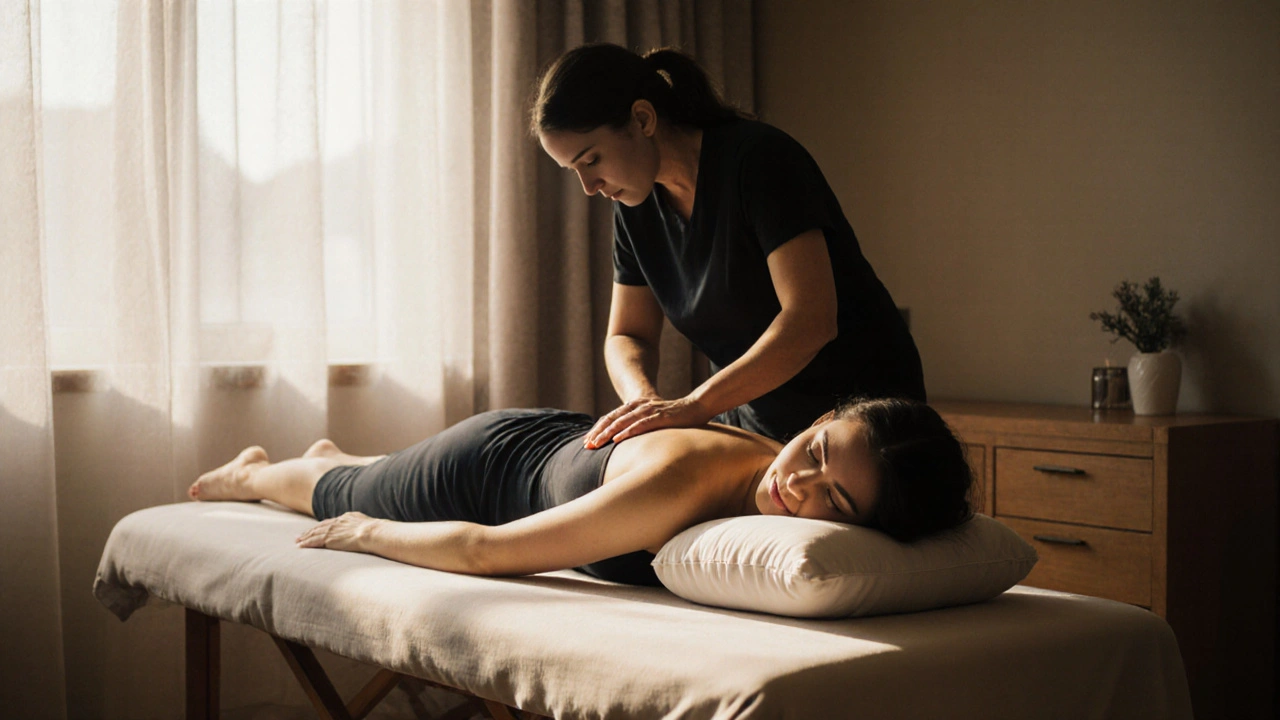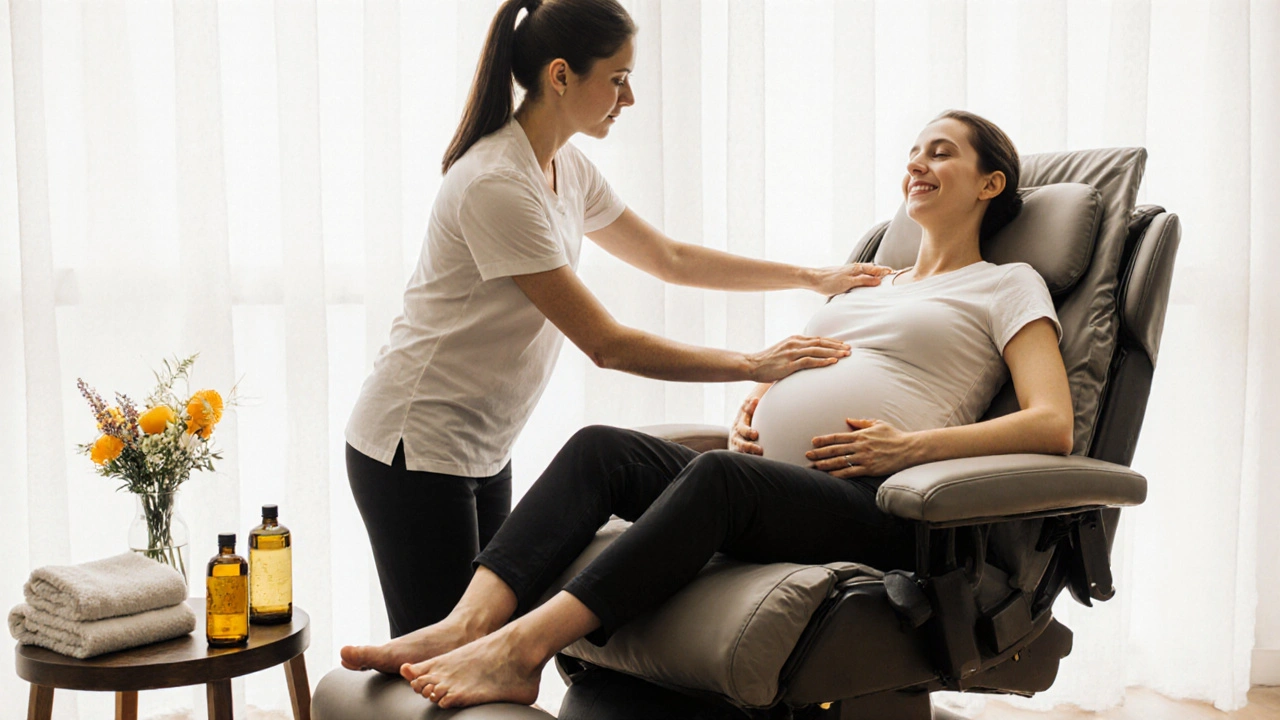Full Body Massage for Expecting Mothers: Safe Techniques and Benefits

Carrying a baby changes your body in ways you can’t always predict. Your back aches from the extra weight. Your feet swell by the end of the day. You can’t sleep because your hips scream for relief. And no matter how many pillows you stack, you still wake up stiff and sore. If you’re pregnant, you’re not alone-these are normal, but they don’t have to be your new normal.
Why Full Body Massage Matters During Pregnancy
Full body massage isn’t just a luxury for expecting mothers-it’s a practical tool for managing pregnancy discomfort. Studies from the Journal of Bodywork and Movement Therapies show that regular prenatal massage reduces cortisol levels by up to 30% and increases serotonin and dopamine, the body’s natural mood boosters. That means less anxiety, better sleep, and fewer headaches.
But it’s not just about feeling good. Massage helps with physical changes too. As your uterus grows, it pulls on surrounding ligaments, causing round ligament pain. Swelling in the ankles? Massage improves circulation and helps move excess fluid. Tight shoulders from hunching over a desk or nursing? A gentle session can loosen those knots without pills or needles.
Unlike over-the-counter painkillers, which many doctors advise avoiding during pregnancy, massage offers relief with zero side effects-when done right.
What Makes Prenatal Massage Different
Not all full body massages are safe during pregnancy. A regular massage table won’t work after the first trimester. Lying flat on your back can compress the vena cava, the big vein that returns blood to your heart. That can cause dizziness, low blood pressure, or even reduced oxygen to your baby.
Prenatal massage therapists use special positioning: side-lying with pillows under your belly and between your knees, or in a semi-reclined chair with support. The pressure is lighter than deep tissue-firm enough to release tension, but never hard enough to cause bruising or discomfort.
Also, not all oils are safe. Essential oils like rosemary, clary sage, and juniper berry can trigger contractions. Reputable therapists use pregnancy-safe carrier oils like sweet almond, grapeseed, or coconut oil, often blended with calming scents like lavender or citrus.
And here’s something most people don’t know: the massage shouldn’t include the inner thighs or ankles. These areas have pressure points linked to the uterus and pelvis. Stimulating them too early or too deeply could, in rare cases, encourage contractions. A trained prenatal therapist knows exactly where to avoid.
When to Avoid Full Body Massage During Pregnancy
Most pregnant women can safely enjoy massage from week 12 onward. But there are times when you should skip it.
- First trimester if you have a history of miscarriage or are experiencing spotting
- If you have preeclampsia, high blood pressure, or severe swelling in your hands and face
- If you’ve been diagnosed with placenta previa or other high-risk conditions
- If you’re running a fever or have an active infection
- If your doctor has advised bed rest
Always check with your OB-GYN before starting any new therapy-even something as gentle as massage. If you’ve had a recent ultrasound showing complications, get written clearance. Better safe than sorry.
What to Expect in a Typical Session
A full body prenatal massage usually lasts 60 to 90 minutes. You’ll lie on your side or in a specially designed pregnancy cushion that cradles your belly and breasts. The therapist will start with your feet and work upward, using slow, rhythmic strokes-similar to Swedish massage but gentler.
They’ll focus on:
- Lower back and sacrum-where most pregnancy pain lives
- Hips and glutes-tight from carrying extra weight
- Shoulders and neck-tense from posture shifts and stress
- Arms and hands-swollen from fluid retention
The pressure is never deep. Think “firm hug,” not “deep tissue.” If it hurts, speak up. You’re in control. A good therapist will adjust on the spot.
Most women leave feeling lighter, calmer, and surprisingly energized. Some even report better fetal movement after a session-likely because improved circulation means more oxygen and nutrients reaching the baby.

DIY Techniques You Can Try at Home
You don’t always need a professional to feel relief. Simple self-massage techniques can help between appointments.
For swollen feet: Sit with one leg crossed over the other. Use your thumbs to gently press from the heel toward the toes. Do this for 2-3 minutes per foot. It helps move fluid out of the tissues.
For lower back: Lie on your side with a pillow between your knees. Place a tennis ball under your lower back and roll slowly for 30 seconds. Don’t press hard-just enough to feel the tension release.
For shoulders: Reach one arm across your chest. Use your opposite hand to gently pull it closer. Hold for 20 seconds. Repeat three times. Do the same for the other side.
And don’t underestimate the power of warm towels. Soak a towel in warm (not hot) water, wring it out, and place it over your lower back for 10 minutes. The heat relaxes muscles without raising your core temperature-something to avoid during pregnancy.
Choosing the Right Therapist
Not every massage therapist is trained in prenatal care. Look for someone with a prenatal massage certification. In Australia, that usually means they’ve completed at least 16 hours of specialized training through a recognized body like the Australian Association of Massage Therapy or the Complementary Medicine Association.
Ask questions before booking:
- Do you have specific training in prenatal massage?
- What kind of positioning do you use for pregnant clients?
- Which oils do you avoid during pregnancy?
- Can you work around my specific discomforts?
Read reviews from other expecting mothers. Look for mentions of comfort, communication, and safety. If a therapist doesn’t ask about your pregnancy stage or medical history, walk away.
Many clinics now offer in-home prenatal massage-convenient if you’re too tired to travel. Just make sure they follow the same safety standards as a clinic.
How Often Should You Get Massaged?
There’s no one-size-fits-all answer. Some women get a massage every two weeks starting in the second trimester. Others wait until the third trimester and go weekly.
Here’s a simple guideline:
- First trimester: Avoid unless cleared by your doctor
- Second trimester: Every 3-4 weeks for maintenance
- Third trimester: Every 1-2 weeks if you’re dealing with pain, swelling, or insomnia
Listen to your body. If you feel more relaxed and less achy after a session, it’s working. If you feel drained or sore afterward, you might be going too often-or the pressure might be too heavy.

Real Stories from Real Mothers
Emma, 34, from Geelong, had severe sciatica at 30 weeks. “I couldn’t sit for more than 10 minutes without screaming. My midwife suggested massage. After two sessions, I slept through the night for the first time in months. I cried the first time I woke up without pain.”
Maya, 29, from Ballarat, struggled with anxiety. “I was terrified of labor. My therapist taught me breathing techniques during massage. I used them during delivery. I didn’t need an epidural.”
These aren’t outliers. They’re women who chose to treat their bodies with care during a time when society often says, “Just endure it.”
What Comes After Birth?
Massage doesn’t stop at delivery. Postpartum massage helps your body recover. It reduces swelling, eases uterine cramping, and supports emotional balance. Many new mothers report less postpartum depression after regular massage sessions.
Just make sure your therapist knows you’ve recently given birth. Techniques change slightly-especially if you had a C-section. Pressure around the scar needs to be very light until it fully heals.
Some clinics offer postnatal packages that combine massage with lactation support or pelvic floor education. Worth asking about.
Final Thoughts
Full body massage during pregnancy isn’t about pampering. It’s about survival. Your body is doing something extraordinary-building a human being-and it deserves support. You don’t have to tough it out. You don’t have to choose between painkillers and discomfort.
With the right therapist, the right timing, and the right approach, massage can turn pregnancy from a struggle into a deeply calming experience. It’s one of the few things you can do that helps you and your baby at the same time.
Start small. Try one session. See how you feel. Then decide if it’s right for you. Your body will thank you.
Is full body massage safe during the first trimester?
Most experts recommend waiting until after the first 12 weeks unless you have a low-risk pregnancy and clearance from your doctor. The first trimester is when the risk of miscarriage is highest, and while there’s no direct evidence linking massage to miscarriage, many therapists avoid it out of caution. If you’re experiencing spotting, severe nausea, or a history of pregnancy loss, skip massage until you’re further along.
Can I lie on my back during a prenatal massage?
No-not after the first trimester. Lying flat on your back can compress the vena cava, a major vein that carries blood back to your heart. This can lower your blood pressure and reduce oxygen flow to your baby. Prenatal massage therapists use side-lying positions or specialized cushions to keep you safe and comfortable. Always confirm your therapist uses proper positioning before your session.
What oils should be avoided during pregnancy massage?
Avoid essential oils like rosemary, clary sage, jasmine, peppermint, and juniper berry. These can stimulate uterine contractions or affect hormone levels. Safe options include sweet almond, grapeseed, coconut, and jojoba oil, often blended with mild scents like lavender or orange. Always ask your therapist which oils they use and why.
Can massage induce labor?
There’s no strong evidence that massage alone can start labor. However, certain pressure points-like those on the ankles and inner thighs-can stimulate uterine activity. That’s why trained prenatal therapists avoid these areas unless you’re past your due date and under medical supervision. Never ask for a massage to induce labor unless your doctor has approved it.
How soon after giving birth can I get a massage?
You can usually start massage within a few days after a vaginal birth, as long as you’re feeling well. If you had a C-section, wait at least 6 weeks or until your scar has fully healed and your doctor gives the go-ahead. Postpartum massage helps reduce swelling, ease cramping, and support emotional recovery. Look for therapists who specialize in postnatal care.
Does insurance cover prenatal massage?
In Australia, most private health insurance plans with extras cover remedial massage, which includes prenatal massage. Check your policy-some require a referral from your GP or midwife. Medicare doesn’t cover massage, but some NDIS participants may qualify for funding if they have a documented pregnancy-related condition. Always ask your provider for a receipt with the therapist’s registration number.
Can my partner give me a massage at home?
Absolutely. Partner massage can be comforting and bonding. Use gentle strokes, avoid pressure points on the ankles and inner thighs, and never press into the belly. Stick to areas like the back, shoulders, feet, and arms. Use pregnancy-safe oils and keep the room warm. It’s not a substitute for professional care, but it’s a great way to connect and relieve stress together.




Seema Donga
November 20, 2025 AT 18:50OMG, this was exactly what I needed to read!! I’ve been so sore since week 20 and thought I just had to ‘tough it out’ like everyone says… but after my first prenatal massage, I cried because I forgot what it felt like to sleep without pain!! Seriously, if you’re pregnant and reading this-just book it!! Your body is doing MAGIC, and you deserve to feel good!! 🙌💖